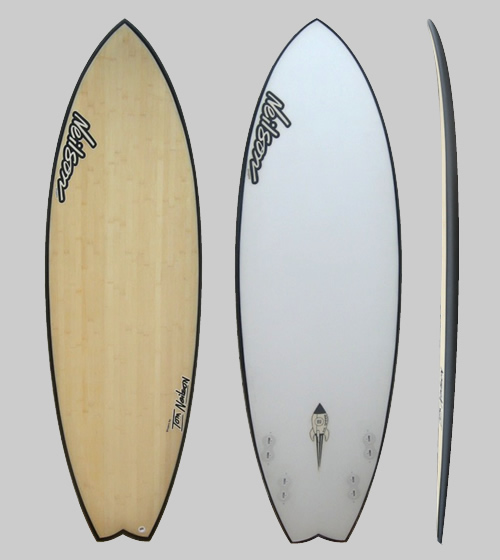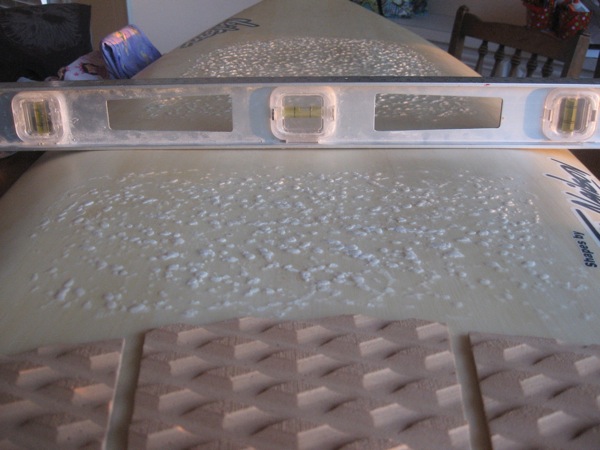Latest board – Bamboo/carbon Floatey Fish
So my trusty old summer board was finally starting to show the effects of 5+ years of abuse. Pretty damn good run for poly 6/6/6 glassed board, but the electrical tape ding repair on the rails was becoming a loosing battle. After a good clean up for some ding repair I realized it was time to replace her.
After a solid year riding my bamboo/carbon rocketfish I was sold on the construction both in performance and durability. Good friend and shaper extraordinaire Tom Neilson got an earful about my latest design experiment, wanting to put a concave deck on my latest board. I’ve been wanting to try a concave deck for years, but was nervous about trying it in a performance shortboard for fear of thinning it out too much and having a really chippy, hard to paddle board. The Floatey Fish hides a LOT of foam and is extremely floatey for it’s size (hence the name). I’ve been riding a 5’10” but even that was a bit corky for my liking so I could go down in size but I figured it would be the perfect board to try a concave deck because it would thin it down some and take a bit of volume out of it but still have plenty of float for the small surf I usually ride it in.
The board turned out great, Tom put a mild 1/4″ concave in the deck but by the time the bamboo veneer and glass were vacuum bagged onto the deck it was closer to 1/8″ concave which is perfect. I didn’t want to go to extremes and overdo it, but it’s almost like a flat deck with a slight depression in the center. This translates to really responsive rail to rail action since the foot is really engaged with the deck.
Enough about the design aspects and on to the real high point of this board, the construction. It’s 1.5# stringerless EPS with a bamboo veneer deck and carbon fiber rails. This build makes for an extremely light board, but the deck veneer gives the deck strength and durability against heel dents and delam. For me this construction is what we’ve been pursuing all these years with Phoresia, a light, durable, great performing board that makes no sacrifices. We had boards made with both Biofoam and IceNine blanks and they board had their drawbacks. This board makes no sacrifices. I’ve had all sorts of boards from Tom – poly, eps/epoxy, stringerless epoxy, custom Coils (back when Coil was doing contract glassing), Biofoam, IceNine, etc. and I’d rate this as the best performing construction I’ve ridden.
With Phoresia we’ve always been searching for a more environmentally friendly board, and while I think this one hits that mark it’s not for the reasons you’d think. There is nothing “green” about this board. It’s EPS, epoxy resin, carbon fiber and bamboo veneer. With the wood look it’d be easy to “greenwash” this construction but the fact of the matter is, it’s all still pretty toxic stuff, minus the bamboo. The real winner for this board is the fact that it should be extremely durable and hopefully last as long as the previous poly version while weighing nearly a pound less. The sad fact of the matter is that our toys are pretty toxic creatures but overall their impact is minimal. We make a bigger impact driving to the beach to surf than we do with our boards. The key is to get a good performing board that is more durable and therefore lasts longer. I’m sold on the bamboo/carbon construction and am stoked to have one of my favorite boards updated and ready for years of abuse.


Its gotta be said that an Epoxy / EPS board is very much less toxic than a PU / PE job. The epoxy is infinitely safer to work with than polyester as long as you don’t use acetone for clear ups as it has no styrene and is low VOC. The EPS is recyclable, whereas polyurethane isn’t in most places. I totally agree with you on the carbon fibre point!
Someone on the web did a cradle to grave study of board building materials and epoxy / EPS came out as the best. Its gotta be a future! Nice article by the way!